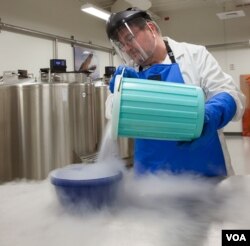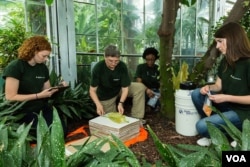A major international effort is in progress to collect and preserve half the genomic diversity of life on Earth.
And the time is running out. Earth is in the midst its sixth mass extinction. The last such event — 66 million years ago — killed off the dinosaurs and practically everything else. Among the estimated 11 million species alive today, only 2 million are described by science. Many may disappear before they even have a name.
Scientists are taking advantage of new genomic technology, however, to speed up the classification process. They are hoping to collect samples from all major branches of the family tree. Every known species of plant and animal is grouped with related species into a larger genus level, and related genera is organized into still larger families.
Quickly gathering samples
On a warm summer day, at the U.S. Botanic Garden, a small group of researchers is collecting samples for the Global Genome Initiative. The ultimate goal, according to Vicki Funk, a senior research botanist with the Smithsonian National Museum of Natural History, is "trying to get one-half of the diversity of plant life on Earth at the genus level in two years.”
That’s a big task. Some 200,000 plant genera are grouped into about 500 scientific families. Funk expects to collect samples from half those families within two months from this one huge greenhouse.
“If you look around you, you see all kinds of plants from all over the world growing right next to one another. So instead of going to Madagascar to get a plant and Hawaii to get a plant, you can get it in rooms that are adjacent to one another,” she said.
Field test-run
Today is a test-run for a process that will be used at 36 partner institutions in 17 countries. Funk is trailed by a small volunteer team that helps photograph a long-stemmed pink flower called Sabatia and takes snippets that are put into silica gel, dropped into liquid nitrogen and then frozen. Funk clipped a blossom and pressed it in a plant book for the museum’s herbarium.
Next on their sampling agenda are the chocolate tree, native to South America, the snowflake aloe, a rare succulent native to Madagascar, and the Sida, one of the original flowers used for making garlands called leis so popular in Hawaii.
All the samples are numbered and linked in a database. The frozen specimens are taken to the Smithsonian National Museum of Natural History Genomics Laboratory for DNA analysis.
Jonathan Coddington, who directs Global Genome Initiative at the museum, said the project is on target to gather samples from all 10,000 plant and animal families, and half the genera within five years.
“Just into our biorepository in the pipeline I have over 2,000 families and close to 12,000 genera,” he said.
Plants frozen for posterity
That biorepository is the largest such facility in the world.
“What we want to do is organize it and get a lot of information evenly spaced out across all of life from bacteria to human,” Coddington explained. “We are now focused on continuing to strategically grow new collaborations with botanic gardens worldwide that share our mission to preserve and unlock the genomic mysteries of plants."
That means a lot of science can get done across many disciplines. On one morning at the Botanic Garden, college student Kristen Van Neste is working alongside Funk.
“What we are doing is important because it is not just for our use, but for future use,” she said.
Van Neste, who is studying to be a conservation ecologist, said she is excited to be a part of the initiative scientists will use to identify species, solve ecosystem problems, monitor effects of climate change and seek new cures for diseases.












